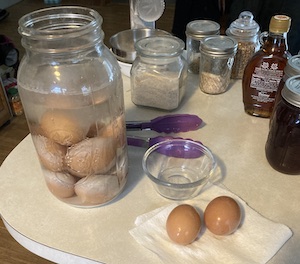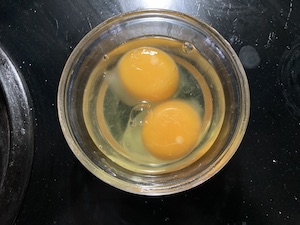The second dozen eggs I had stored in lime-water last May was now 10 months old. Time for the second taste test. How did they do? Read on.

I tested the first of the two half-gallon jars of stored eggs last September. Here’s the post for that taste-test. They were okay, as you can read. This week, I began eating those in the second jar.
I went through the usual washing process and broke the eggs into a small bowl so I could inspect them better.
The shells seemed a little more fragile this time around, breaking easier. I’m not sure about that. It was just an impression. The yoke of my first egg broke but I couldn’t tell if it was stuck to the shell or if I was just clumsy in my breaking. The second egg came out with the yoke intact. I noticed that the whites were a little cloudy, not totally clear.


When I dumped them into the skillet, the other yoke broke so I scrambled them in the pan. They cooked up pretty much like you’d expect eggs to cook. The whites were runnier and less apt to get fluffy.
They tasted like…well, actually, they seemed to have less taste. Not a bad taste, or an after-taste, or anything, just less egg flavor. They reminded me of grocery store eggs that way.
During the week of breakfasts, I got better at cracking the shells and was able to get the yokes out without breaking them. But, when I poured the bowl of eggs into the fry pan, the yokes always split. So now I’m having second thoughts on the yoke-stuck-to-shell theory. It seems like the yokes’ membrane is weaker after ten months in storage so they’re just more likely to break. I also noticed the yokes sat flatter in the pan. With fresh eggs — only a few days old — the yoke sits high, like it’s trying to still be a sphere. The ten-month-old egg yokes sat low and wide.
Practical Limits?
At ten months since the previous spring laying peak, my flock has started to ramp up their laying again. They’re not up to full speed of an egg-a-day per bird, but they’re working on it. Since, at this time of year, they’re laying better, we’re getting more eggs per day than we typically eat, so I really don’t need time-shifted eggs from last spring.
After testing this storage method, I’m thinking that it is better suited to medium-term storage rather than long-term storage. I’m always looking for a way to time-shift the glut of eggs I get in the spring and early summer to have them available in the fall when the flock goes into The Molt and we’re getting very few eggs (or none). Six months is really all I’d need to fill that hole. For that use, the lime-water storage method works well. I’ll be doing that again later this spring with a few more dozen eggs. I’ll be testing re-use of the lime water too, compared to jars of freshly made.
Longer Term?
I will still be dehydrating and powdering surplus eggs in the spring. While I’ll never get an over-easy egg out of them, they are a long-term storage solution for my extra eggs, and for a time when I might need them. For a look at that process, here is an earlier post in which I showed how make my powdered eggs.
Bottom Line
I like the lime-water method for time shifting some of my excess eggs from spring surplus to fall scarcity, within the same year. For prepping and longer storage, I’ll still be dehydrating. Both methods have their place in our food management and food storage plans.
—

Sounds like a successful experiment.
Looking forward to seeing if the lime water can be recycled.
Thanks for the report.
I was looking at when molting occurs vs egg production. Seems young hens less than a year old do not molt? Yet they can start laying at 18 weeks?
Do commercial egg farms rotate chickens yearly as egg prices don’t seem to vary that much year round?
Hi Michael, Yes, a successful time-shifting of homegrown foods.
You’re right that a young hen doesn’t molt in her first autumn. I suspect big commercial egg farms do rotate their birds. Having part of the commercial flock could be timing their hatches so the young and newly-laying are doing so when the old birds do their molt. Since they usually keep the lights on to keep them laying during the winter, a commercial bird doesn’t get to live that long. They’re pretty well played out after a couple years. They might get only one molt before they’re ‘retired.’
I’m keen to see if re-used lime water works too. Will have a side-by-side test with newly mixed lime water and last year’s. But, that test is a good six months away.
Mic, I was doing some reading. You know that Ducks lay eggs year-round? Khaki Campbells lay around 180-240 eggs a year. They go broody and can lay for over 5 years.
Needs more research. Year round eggs seems useful.
I have a friend who was keeping ducks but is getting rid of them. She says they’re a lot messier than chickens, what with needing a ‘pond’ but also popping up that pond. And, she says, are prone to lay their eggs where THEY want, rather than in a nest box. She wasn’t selling me on keeping ducks.